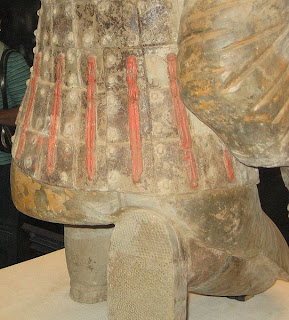Emperor Qin’s Terra Cotta Army was constructed by 700,000 laborers who were ordered to do so by the Qin Dynasty’s first emperor, Emperor Qin Shi Huangdi sometime between 210 to 209 BC.
According to a local historian known as Sima Qian who was there from the beginning of the construction of Terra Cotta until the end, the construction started in 246BC when Emperor Qin was just 13 year old. The necropolis was found by local formers while digging water well in Lintong district, Xi’an, Shaanxi on Mount Lishan in 1974. The founding was dug out and kept in close ever since.
The pits in the necropolis are 230m long going 1.5km to the east, each about 7m deep. The warrior statues are of actual human height, measuring 5.7ft on average. They vary according to the roles of the warriors. For example, the high ranked generals are slightly taller than the low ranked army.
The warriors were made of yellow clay which was mainly composed of silicon oxide, aluminium oxide and ferric oxide. The same clay was used as the emperor’s eve tile. The earth soil was used for wall of pits.
There are many elements that can be noticed in this artwork. Real swords and armor were found attached to the warriors. Traces of chromium oxide show that the armors were coated to avoid rusting.
Also can be seen, each and every warrior has different faces and expressions. Faded colours found on the statues indicate presence of paintings. Mainly, the art work has the earth tone. The composition only involves brown, yellow ochre and grey. The shadow and light during day and night time gives orange and black colour for the contrast. There are all together 8000 soldiers, 130 chariots, 520 horses and 150 cavalry horses. All these characters have the characteristics of ancient war. There were all arranged in only vertical and horizontal lines and rows just like an army base ready for war.
Studies by archeologist and historians show that the construction of the Terra Cotta warriors started from heads, arms, legs and the torsos separately before assembling them together. Once complete with body, actual armors and weapons were attached to them to give a more realistic appearance. It was also told that Emperor Qin strictly said that no faces should look alike, and thus, 8 different molds were used to create the heads and clay was used to make facial expressions. Once complete, colour lacquer or colour gloss was used to paint them.
After the necropolis was dug out, robbers stole some of the weapons and the climate had faded the colours.
There are 4 pits all together, each pit with different contents. The first pit has 8000 figures. They were believed to be noblemen as the 11 corridors and the wideness imitates the palace hallway. The wooden ceiling is covered with reed meets and layers of clay which makes them water proof. The second pit consists of chariots and military guards. It’s called the cavalry and infantry units. Whereas the third pit, is known as the command post. It consists of high ranking generals, officers and war chariots. However, the fourth pit was left empty. It is unknown whether it was left empty intentionally, incomplete or they went missing.
Viewing the whole art work, to me, it makes me think about the thousands of millions of sacrifices for the country by the people during ancient war. Their strategic arrangement illustrates their strong will and discipline. After reading up, the art work demonstrates how much power Emperor Qin Shi Huangdi for such huge monumental undertaking at the age of 13. To Emperor Qin, he wanted the Terra Cotta Empire to control the resources of the newly formed China and to main the empire in his afterlife which is a great success myth logically.
The art work is imitative as the objects imitate the First Qin Dynasty warriors, their trend and style that were obviously seen in the clothing, weapons, armors and hairstyle.
Also, the arrangement of the warriors imitates the ancient war time strategic positioning. The artwork also serves its function by reminding the people of the Qin dynasty’s strength and power to the world and to future generation.
Emperor Qin’s intention in building such necropolis is to rule China even in his afterlife and to main the empire.
When the artwork was under construction, it was aimed to the whole world, mainly to the Chinese and future emperors and other conquerors after 250BC. Now, Terra Cotta Empire is being viewed and studied by archeologists, geographers, historians and also art students.
There are no one left out from being an audient here, only limitations. Since it has 3D value, and it is situated in China, it is pretty difficult for viewers to have a clear understanding of each statue. However, even that has been simplified as 120 objects and 20 terra cotta warriors were displayed in an exhibition called “The First Emperor : China’s Terracotta Army” started in the British Museum, London in 2007, followed by California, Atlanta, South Ana, Washington DC, and Australia.











